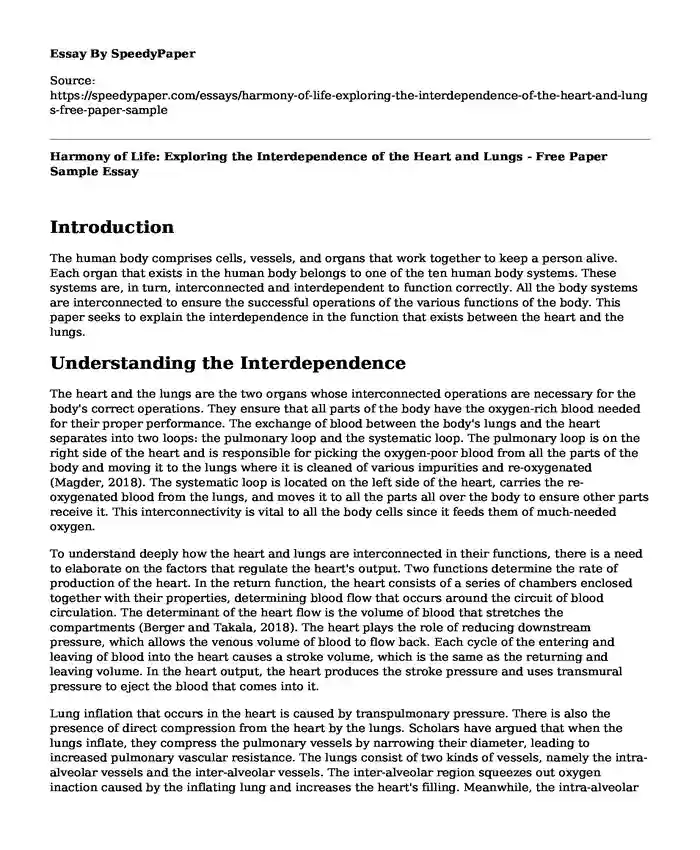
| Type of paper: | Essay |
| Categories: | Medicine |
| Pages: | 3 |
| Wordcount: | 712 words |
Introduction
The human body comprises cells, vessels, and organs that work together to keep a person alive. Each organ that exists in the human body belongs to one of the ten human body systems. These systems are, in turn, interconnected and interdependent to function correctly. All the body systems are interconnected to ensure the successful operations of the various functions of the body. This paper seeks to explain the interdependence in the function that exists between the heart and the lungs.
Understanding the Interdependence
The heart and the lungs are the two organs whose interconnected operations are necessary for the body's correct operations. They ensure that all parts of the body have the oxygen-rich blood needed for their proper performance. The exchange of blood between the body's lungs and the heart separates into two loops: the pulmonary loop and the systematic loop. The pulmonary loop is on the right side of the heart and is responsible for picking the oxygen-poor blood from all the parts of the body and moving it to the lungs where it is cleaned of various impurities and re-oxygenated (Magder, 2018). The systematic loop is located on the left side of the heart, carries the re-oxygenated blood from the lungs, and moves it to all the parts all over the body to ensure other parts receive it. This interconnectivity is vital to all the body cells since it feeds them of much-needed oxygen.
To understand deeply how the heart and lungs are interconnected in their functions, there is a need to elaborate on the factors that regulate the heart's output. Two functions determine the rate of production of the heart. In the return function, the heart consists of a series of chambers enclosed together with their properties, determining blood flow that occurs around the circuit of blood circulation. The determinant of the heart flow is the volume of blood that stretches the compartments (Berger and Takala, 2018). The heart plays the role of reducing downstream pressure, which allows the venous volume of blood to flow back. Each cycle of the entering and leaving of blood into the heart causes a stroke volume, which is the same as the returning and leaving volume. In the heart output, the heart produces the stroke pressure and uses transmural pressure to eject the blood that comes into it.
Lung inflation that occurs in the heart is caused by transpulmonary pressure. There is also the presence of direct compression from the heart by the lungs. Scholars have argued that when the lungs inflate, they compress the pulmonary vessels by narrowing their diameter, leading to increased pulmonary vascular resistance. The lungs consist of two kinds of vessels, namely the intra-alveolar vessels and the inter-alveolar vessels. The inter-alveolar region squeezes out oxygen inaction caused by the inflating lung and increases the heart's filling. Meanwhile, the intra-alveolar vessels are stretched, and they acquire volume (Pinsky, 2018). There are no other organ systems closely correlated in terms of functions like how the lungs and the heart are linked. Various organs that make up the ten human body systems are not interdependent, like the heart and the lungs. Parts of the body that are connected like the skin and the nervous system are, most of the time-dependent on the other organs. For example, the skin waits for the senses to be detected by the nervous system to react to the stimulation. However, the relationship between the skin and the nervous system needs to be explored further.
Conclusion
The body consists of various body parts that work together to enable a person to live. There is excellent interdependence between the heart and the lungs, with some functions affecting how the other operates. Scholars have discussed the various means by which both the lungs and the heart's functions contribute to their effective functioning.
References
Berger, D., &Takala, J. (2018). Determinants of systemic venous return and the impact of positive pressure ventilation. Annals of translational medicine, 6(18). https://www.ncbi.nlm.nih.gov/pmc/articles/pmc6186556/
Magder, S. (2018). Heart-Lung interaction in spontaneous breathing subjects: the basics. Annals of translational medicine, 6(18). https://www.ncbi.nlm.nih.gov/pmc/articles/PMC6186567/
Pinsky, M. R. (2018). Cardiopulmonary interactions: physiologic basis and clinical applications. Annals of the American Thoracic Society, 15(Supplement 1), S45-S48. https://scholar.google.com/scholar?output=instlink
Cite this page
Harmony of Life: Exploring the Interdependence of the Heart and Lungs - Free Paper Sample. (2024, Jan 08). Retrieved from https://speedypaper.net/essays/harmony-of-life-exploring-the-interdependence-of-the-heart-and-lungs-free-paper-sample
Request Removal
If you are the original author of this essay and no longer wish to have it published on the SpeedyPaper website, please click below to request its removal:
- Essay Example - Contraceptive Pills
- Free Essay on Protein Biological Products: Domestic Source to Overseas Source
- Mentorship in a Mental Health Facility, Essay Example
- Essay Sample on Mr. Simmons' Medical Diagnosis
- Free Essay Example. the Homeless and Health Promotion
- Free Essay: Elaboration on the Role of Non-Health Factors in Behavior Change
- Essay Example: Implementing Policies in the Healthcare Delivery System
Popular categories




